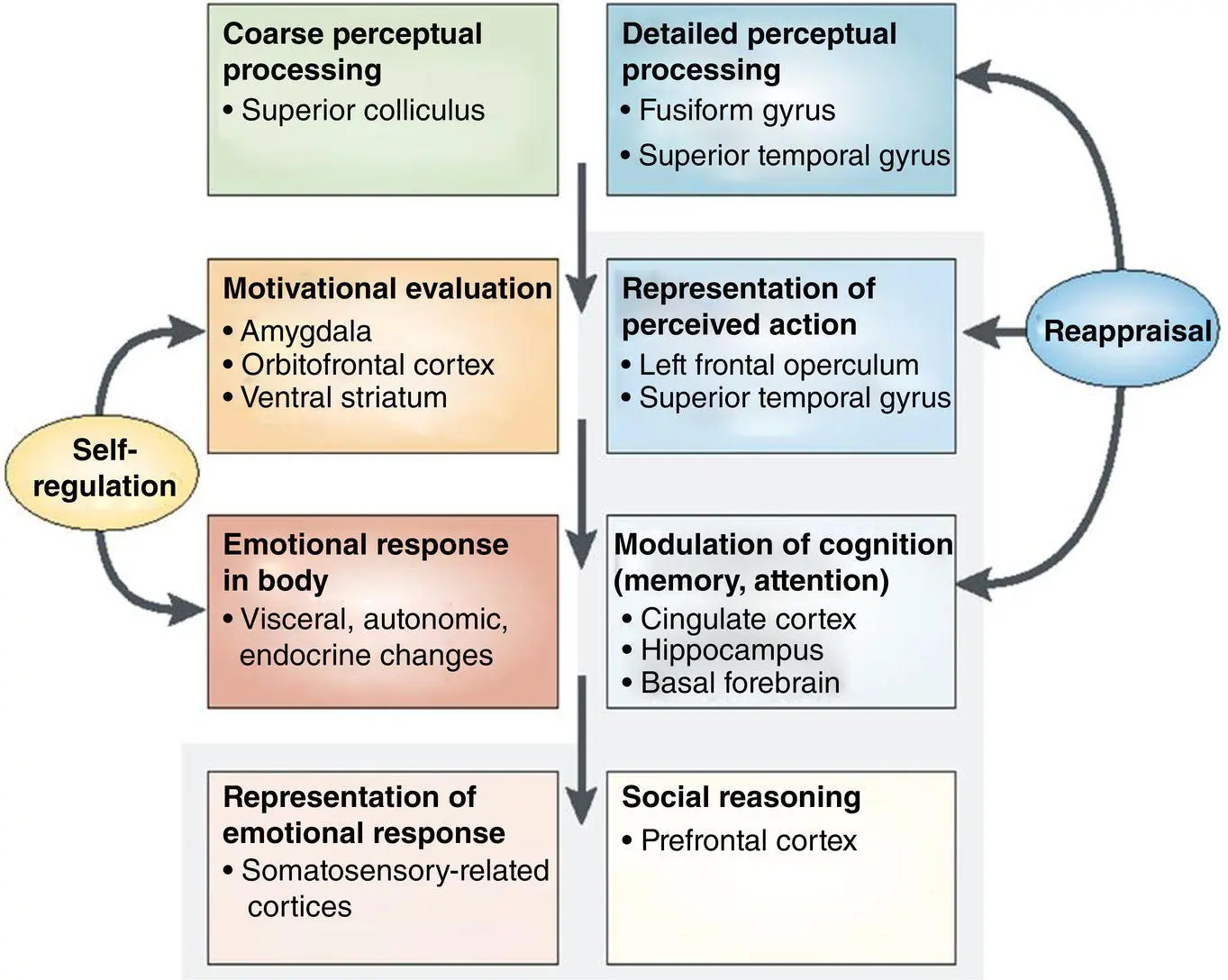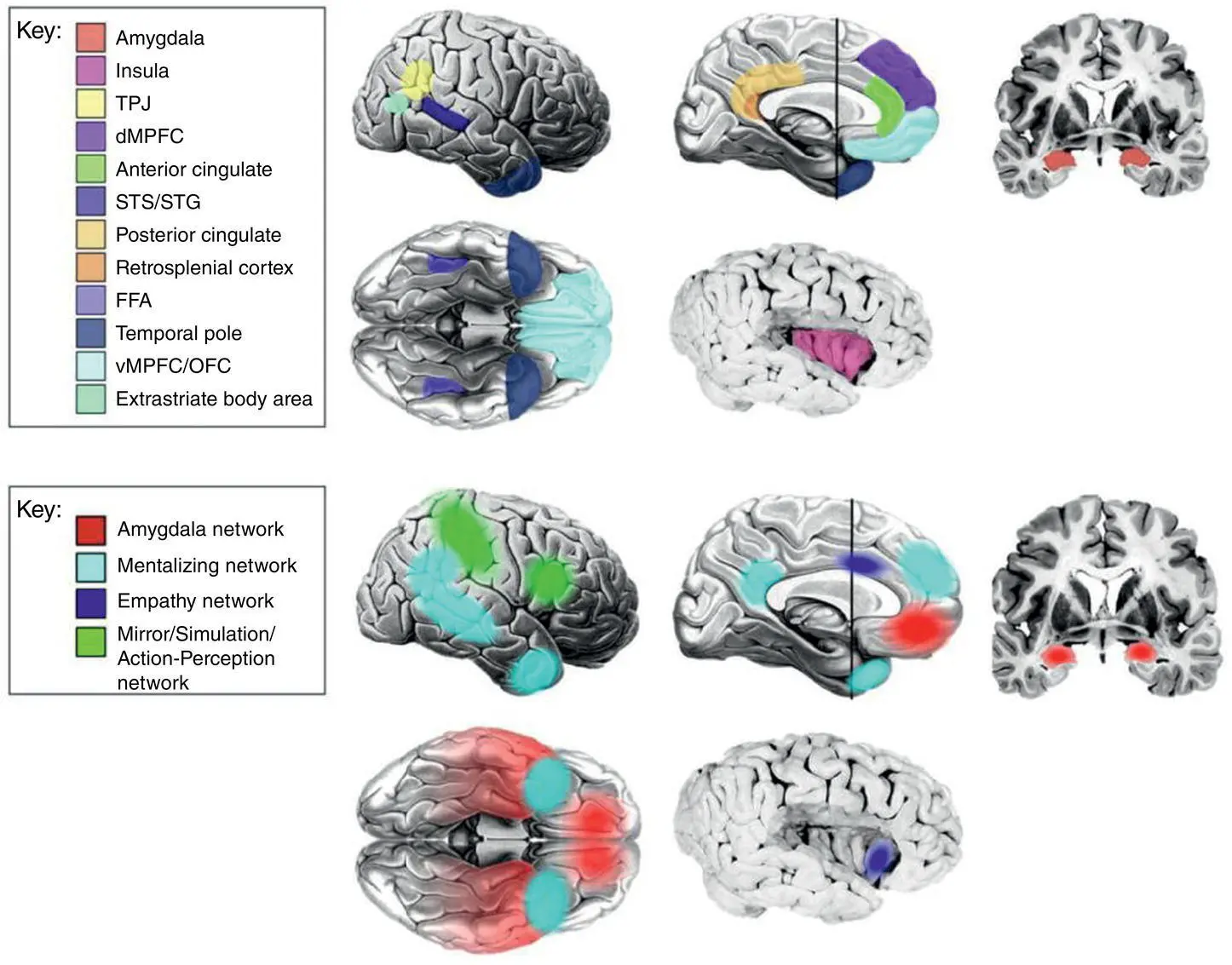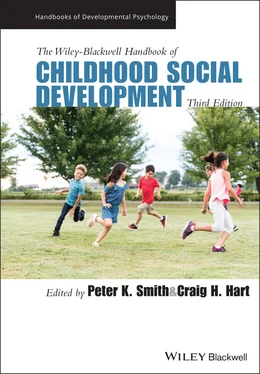What was learned from adult lesion studies began to be applied to children and the developing brain, facilitated with the advent of contemporary neuroimaging in the 1970s (Bakker, 1984). With neuroimaging firmly in place as a clinical investigative tool to study acquired brain injury in infants and children, along with in vivo neuroimaging examinations of the infant or child brain with some type of developmental disorder or disease, the inferences from adult studies about critical brain areas of the frontal, temporal, and limbic regions for social functioning were confirmed in children (Cattelani et al., 1998; Eslinger & Biddle, 2000; Jacobs & Anderson, 2002; Janusz et al., 2002). Summarizing these lesion‐localization studies in children, Figure 3.5from Yeates et al. (2007) and Figure 3.6from Adolphs (2003) highlight major candidate brain regions assumed to participate in the development of social behavior. Table 3.1summarizes these key brain regions and their presumed role related to cognition and behavior. In Figure 3.6, Adolphs emphasizes the feedback relations between self‐regulation and reappraisal in regulation of the social brain.
Implied in the identification of candidate brain regions that contribute to social behavior, as shown in Figures 3.5and 3.6and Table 3.1is that these brain regions were intimately interconnected, emphasizing the importance of myelination and WM integrity. Optimal functioning and integration of these regions likely underlies prosocial, normative development. But how do these regions and networks come on‐line and how can that be demonstrated and investigated in the developing child in relation to social behavior? Diffusion tensor MRI was introduced in Figure 3.2which included an illustration of network development in the maturing brain. In the last decade, dramatic improvements in how to study and identify brain networks has been established, especially in terms of the mathematical features of “graph theory” applied to social neuroscience (Bassett & Bullmore, 2017).

Figure 3.5 Candidate “social brain” regions
(Reproduced with permission from Yeates et al., 2007). Reproduced with permission from the American Psychological Association.

Figure 3.6 Critical regions and reciprocal relations of the social brain
(Reproduced with permission from Adolphs, 2003). Reproduced with permission from Nature Publishing.
Myelinated axons are the centerpiece of neural networks that provide the interlinking of brain regions. In graph theory, a connector (pathway) is referred to as an “edge,” which connects different regions through nodes and hubs. The most efficient connections, if fully functional, probably involve the fewest and shortest pathways (edges). What is shown in Figure 3.2is a whole‐brain schematic using DTI‐derived myelinated axons aggregated into a network. The lines in Figure 3.2c represent pathways, the size of the line and different shading reflecting different aspects of a functioning network and their strength, possibly related to importance. As more networks come online with maturation, the spherical representation of a hub or node importance, is reflected by its increased size ( Figure 3.2c).
Kennedy and Adolphs (2012) use these and other methods to derive a cognitive neuroscience framework for these key brain regions and networks that participate in self‐regulation and monitoring of social behavior. Their model, presented in Figure 3.7, is based on just four networks – amygdala, mentalizing, empathy, and mirror (see Tables 3.1and 3.2). As will be discussed in the next section, numerous networks are at play in regulating the social brain, but for demonstrable purposes the networks discussed by Kennedy and Adolphs are what are presented here.
Since most of the prior research and clinical understanding for the role of these brain regions in social behavior came from the damaged brain, it was important for investigators of age‐typical, healthy brain development to study these candidate “social brain” regions in those who did not have some acquired or developmental neuropathology. Social and neuropsychological methods through behavioral assessments had long been able to identify children with differences in social and adaptive behaviors, for example, the acquisition of reciprocal play. Like most behaviors, using behavioral testing and observational studies, the acquisition and mastery of certain social behaviors could be plotted on a spectrum – early versus late, age‐typical versus delayed, etc. The paradigm shift with neuroimaging was to design experiments with these types of differing behavioral characteristics of social behavior and then scan these children and adolescent research participants, quantitatively analyzing their brains with some of the neuroimaging techniques described in this chapter, especially in the next section. Similarly, these neuroimaging methods have been applied to the study of children with neuropsychiatric disorders, with particular emphasis on clinical syndromes involving social‐emotional functioning (Li et al., 2020). The next section discusses some of these methods and their application to studying the social brain.
Table 3.1 Candidate regions that participate in the social brain.
| Somatosensory cortices |
Representation of emotional response |
|
Viewing others’ actions |
| Fusiform gyrus |
Face perception |
| Superior temporal gyrus |
Representation of perceived action |
|
Face perception |
|
Perception of gaze direction |
|
Perception of biological motion |
| Amygdala |
Motivational evaluation |
|
Self‐regulation |
|
Emotional processing |
|
Gaze discrimination |
|
Linking internal somatic states and external stimuli |
| Ventral Striatum |
Motivational evaluation |
|
Self‐regulation |
|
Linking internal somatic states and external stimuli |
| Hippocampus and temporal poles |
Modulation of cognition |
|
Memory for personal experiences |
|
Emotional memory retrieval |
| Basal forebrain |
Modulation of cognition |
| Cingulate cortex |
Modulation of cognition |
|
Error monitoring |
|
Emotion processing |
|
Theory of mind |
| Orbitofrontal cortex |
Motivational evaluation |
|
Self‐regulation |
|
Theory of mind |
| Medial frontal cortex |
Theory of mind |
|
Action monitoring |
|
Emotional regulation |
|
Emotional responses to socially relevant stimuli |
|
Monitoring of outcomes associated with punishment and reward |
| Dorsolateral frontal cortex |
Cognitive executive function |
|
Working memory |

Figure 3.7 Network ROIs within four critical brain networks underling social cognition and brain function
Читать дальше















